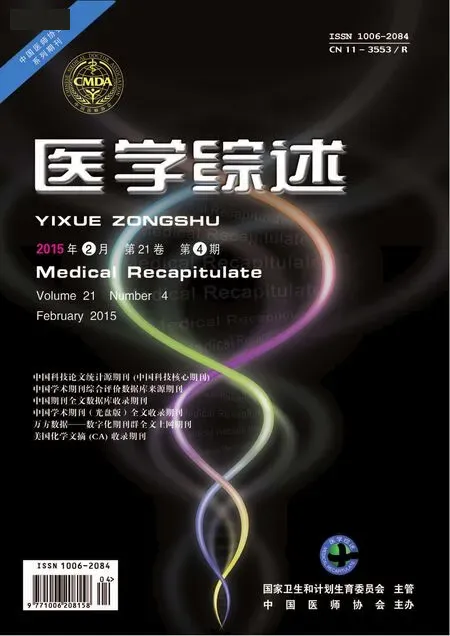嘌呤受体:缓解阿片耐受的一个潜在靶点
2015-02-09综述李伟彦审校
周 宁(综述),李伟彦(审校)
(南京军区南京总医院麻醉科,南京 210002)
嘌呤受体:缓解阿片耐受的一个潜在靶点
周宁△(综述),李伟彦※(审校)
(南京军区南京总医院麻醉科,南京 210002)
摘要:神经胶质细胞在阿片类药耐受的发生和维持中发挥着重要的作用。胶质细胞上嘌呤受体的激活可诱导其合成和释放促炎因子、神经活性物质等,参与神经病理性疼痛及阿片耐受的形成和维持。靶向抑制嘌呤受体的各种亚型在神经病理性疼痛和阿片耐受的研究中已取得初步进展,其可能成为缓解阿片耐受的重要治疗靶点。因此,理解嘌呤受体的结构和生物学功能可能为临床治疗阿片耐受提供新的选择。
关键词:嘌呤受体;阿片耐受;胶质细胞
阿片类药的耐受现象严重影响疼痛的治疗效果、增加不良反应,如头晕、恶心、呕吐、便秘等[1],这限制了其在临床上的广泛应用。阿片耐受的机制包括阿片受体的脱敏及谷氨酸N-甲基-D-天冬氨酸受体和谷氨酸转运蛋白的功能改变[2],但是这些并没有完全阐明阿片耐受的确切机制。近年来胶质细胞活化在阿片耐受发生和维持中的作用逐渐被认识,其中胶质细胞表达的嘌呤受体成为人们关注的焦点。嘌呤受体活化刺激胶质细胞合成和释放的促炎因子、神经活性物质等与阿片耐受的发生和维持密切相关,因此嘌呤受体可能是缓解阿片耐受的一个重要靶点,现就相关研究进展进行综述。
1嘌呤受体的结构和功能
嘌呤受体分为P1和P2受体两大类,P1受体主要由腺苷激活,属G蛋白偶联受体家族,包括A1、A2A、A2B、A3四类;P2受体主要由核苷酸激活,分为两个家族,亲离子受体(P2X)和代谢型G蛋白偶联受体(P2Y)[3]。已有7种P2X受体(P2X1~7)和8种P2Y受体(P2Y1、P2Y2、P2Y4、P2Y6、P2Y11~14)亚型被克隆[4]。
P2X受体属于配体门控离子通道家族且对Na+和K+具有等渗透性,对Ca2+具有显著渗透性的阳离子选择性通道[5-6]。到目前为止分子克隆已经鉴别出能编码P2X受体亚基的7种基因(P2X 1~7)。所有P2X亚基具有两个跨膜区和具有细胞内N端、C端及跨膜结构域之间的长胞外环[6-7]。考虑到电流动力学,脱敏率及对激动剂和拮抗剂的灵敏度,7个同效P2X受体的每一个和至少4个异源受体显示了不同的电生理和药理学性能[8]。当它们中的每一个或两个在细胞中异源的表达,ATP就会引起一个快速或慢速钝化内向电流。快速内向电流在表达P2X1或P2X3受体的细胞中被观察到,慢速钝化内向电流在那些表达包括4个异源受体的所有其他受体中可以观察到[5-6]。因此,被ATP反复活化的P2X1和P2X3引起了明显的ATP诱导反应的脱敏。α,β亚甲基ATP是ATP的类似物,能激活P2X4/6,对包括P2X1或P2X3在内的P2X受体也是有用的激动剂[6]。
P2Y受体是糖基化后集中在(41~53)×103的308~377个氨基酸蛋白。这7个跨膜区中P2Y受体的三级结构有共同的G蛋白偶联受体。P2Y被嘌呤、嘧啶核苷酸或有亚基依赖的异源三聚体G蛋白的糖核苷酸所激活[3]。对核苷酸活化的反应,重组体P2Y受体能通过Gαq/11激活磷脂酶C-三磷酸肌醇通路,重组体P2Y受体轮流释放胞内钙并激活蛋白激酶C或影响腺苷酸环化酶并通过Gαi/o改变环腺苷酸水平[3]。
2P2X受体与阿片耐受
2.1P2X4受体在体外培养的小胶质细胞中通过直接的μ受体信号吗啡增强了小胶质细胞Ca2+结合适配器分子1的表达和P2X4受体介导的小胶质细胞的迁移[9]。P2X4受体推进了吗啡耐受并调节吗啡诱导的脊髓胶质细胞反应性。另外,血管周围的小胶质细胞在吗啡耐受中发挥重要作用而P2X4受体的表达调节了血管周围小胶质细胞特异性巨噬细胞单抗2的表达。吗啡通过磷脂酰肌醇-3-激酶/丝苏氨酸蛋白激酶通路和μ阿片受体依赖的方式增强了P2X4受体介导的小胶质细胞迁移。P2X4受体在慢性疼痛中起作用,P2X4受体功能的药理学抑制剂和P2X4受体表达的反义寡聚核苷酸抑制了L5脊神经横断引起的触诱发痛[10]。小胶质细胞P2X4受体的活化刺激脑源性神经营养因子的合成和释放[11],而脑源性神经营养因子是神经元环路中重要的抗阿片肽,它的分泌增加会抑制吗啡的镇痛效应[12]。P2X4受体反义寡聚核苷酸减弱了连续吗啡注射引起的镇痛耐受的形成,减弱了吗啡诱导的脊髓中P2X4受体、Ca2+结合适配器分子1、神经胶质纤维酸性蛋白和μ阿片受体的表达而增加了特异性巨噬细胞单抗2表达[9]。
2.2P2X7受体P2X7受体是ATP门控非选择性阳离子通道[13]。研究表明,P2X7受体在促炎因子白细胞介素1β[14]和肿瘤坏死因子α[15]的形成中发挥重要作用。P2X7受体拮抗剂或靶向小干扰RNA阻断P2X7受体在疼痛行为测试和体内的脊髓细胞外记录及体外脊髓的整个细胞记录方面能减弱吗啡镇痛耐受[16]。鞘内注射选择性P2X7受体抑制剂Brilliant Blue G(BBG)能明显减少吗啡镇痛效能的降低,P2X7R的上调和小胶质细胞的活化,此外,靶向干扰脊髓P2X7受体显示了相似的耐受减弱效果。p38 丝裂原活化蛋白激酶(p38 mitogen-activated protein kinase,p38MAPK)作为各种胞外刺激的转换器,调节炎性因子的释放[17],且参与和小胶质细胞相关的吗啡镇痛耐受的形成[18]。脊髓P2X7受体的药理学拮抗剂和小干扰RNA抑制剂都抑制了脊髓小胶质细胞和p38MAPK的活性,表明p38MAPK是吗啡耐受中P2X7受体活化的下游因子[19]。P2X7受体介导的谷氨酸释放可能是引起N-甲基-D-天冬氨酸受体活化的重要成分。慢性吗啡下调谷氨酸转运蛋白,而谷氨酸转运蛋白的活化减弱了吗啡镇痛耐受[20]。研究表明,P2X7受体的活化减弱了谷氨酸转运蛋白效能[21]。P2X7R更可能通过破坏谷氨酸的释放和吸收的平衡而引起吗啡镇痛耐受。P2X7受体拮抗剂BBG明显减弱了慢性吗啡引起的脊髓感受伤害敏感神经元兴奋性的增加。胞外ATP,P2X7受体内源性配基,在神经元和胶质细胞的联系中扮演功能依赖性信号分子[22]。许多因素包括炎症、酸中毒、受体活性和胞膜去极化都能触发神经元和胶质细胞中ATP的释放。谷氨酸能诱导脊髓和脑皮质的胶质细胞释放过量的ATP[23]。慢性吗啡能增加吗啡耐受大鼠脑脊液中谷氨酸的浓度,这可能导致局部胞外环境中高浓度的ATP从而触发脊髓P2X7受体的活化[24]。因此,活化的P2X7受体通过正反馈引起ATP和谷氨酸的释放,进一步促进吗啡耐受中P2X7受体的持续活化[25]。
3P2Y受体与阿片耐受
3.1P2Y6受体培养的小胶质细胞表达P2Y6受体[26],并且外周神经损伤后脊髓中P2Y6信使RNA的表达明显增多,这个时间过程与触诱发痛是一致的。小胶质细胞中P2Y6的功能仍然不清楚,尿苷二磷酸,P2Y6的激动剂添加到培养的小胶质细胞易化了噬菌作用[26]。注射红藻氨酸诱导的神经损伤引起了海马小胶质细胞中P2Y6受体的上调。红藻氨酸诱导的神经损伤导致胞外尿苷三磷酸的增加,在体内外它立刻被代谢为尿苷二磷酸。从受损神经元中渗漏的尿苷二磷酸引起了P2Y6受体依赖的噬菌作用。神经元损害时P2Y6受体上调,可能通过传感扩散性的尿苷二磷酸信号对噬菌作用起感受器的作用[27]。
3.2P2Y12受体P2Y12受体是神经病理性疼痛的关键调节者之一[28-29]。鞘内注射P2Y12受体拮抗剂,如MRS2395和ARC69931MX或P2Y12受体的反义寡聚核苷酸,明显抑制了脊髓神经损伤[29]和坐骨神经损伤[28]引起的神经病理性疼痛的发生。Cui等[18]证实,脊髓小胶质细胞p38MAPK的活化介导了吗啡镇痛耐受的发生,通过抑制脊髓小胶质细胞p38MAPK能减弱外周炎症引起的痛觉高敏。靶向p38MAPK的药物可抑制阿片类药物耐受、依赖等不良反应,增强其镇痛效能,减少药物用量。坐骨神经损伤后p38MAPK的磷酸化总是能被P2Y12受体拮抗剂或反义寡聚核苷酸完全抑制[28]。
4结语
中央神经系统胶质细胞激活在吗啡镇痛耐受和神经病理性疼痛的发生和维持中发挥重要作用的观点得到广泛认可,而嘌呤受体通过激活中央神经系统胶质细胞,促进神经活性物质、促炎因子的合成与释放,参与神经病理性疼痛和吗啡耐受的产生和维持。进一步观察嘌呤受体在中央神经系统中胶质细胞及其他器官的分布,探讨其下游的信号通路,能更好地理解其在神经病理性疼痛、吗啡镇痛耐受及其他相关疾病中的作用机制,为临床上治疗相关疾病提供新选择。
参考文献
[1] 赵鹤,梁语丝.阿片物质对免疫系统的作用[J].医学综述,2012,18(7):989-991.
[2]Martini L,Whistler JL.The role of mu opioid receptor desensitization and endocytosis in morphine tolerance and dependence[J].Curr Opin Neurobiol,2007,17(5):556-564.
[3]Abbracchio MP,Burnstock G,Boeynaems JM,etal.International Union of Pharmacology LⅧ:update on the P2Y G protein-coupled nucleotide receptors:from molecular mechanisms and pathophysiology to therapy[J].Pharmacol Rev,2006,58(3):281-341.
[4]Burnstock G.Purinergic signalling:past,present and future[J].Braz J Med Biol Res,2009,42(1):3-8.
[5]Khakh BS,Burnstock G,Kennedy C,etal.International union of pharmacology.XXIV.Current status of the nomenclature and properties of P2X receptors and their subunits[J].Pharmacol Rev,2001,53(1):107-118.
[6]North RA.Molecular physiology of P2X receptors[J].Pharmacol Rev,2002,82(4):1013-1067.
[7]Vial C,Roberts JA,Evans RJ.Molecular properties of ATP-gated P2X receptor ion channels[J].Trends Pharmacol Sci,2004,25(9):487-493.
[8]Jarvis MF,Khakh BS.ATP-gated P2X cation-channels[J].Neuropharmacology,2009,56(1):208-215.
[9]Horvath RJ,Romero-Sandoval EA,Leo JAD.Inhibition of microglial P2X4 receptors attenuates morphine tolerance,Iba1,GFAP and μ opioid receptor protein expression while enhancing perivascular microglial ED2[J].Pain,2010,150(3):401-413.
[10]Tsuda M,Shigemoto-Mogami Y,Koizumi S,etal.P2X4 receptors induced in spinal microglia gate tactile allodynia after nerve injury[J].Nature,2003,424(6950):778-783.
[11]Hanisch UK,Kettenmann H.Microglia:active sensor and versatile effector cells in the normal and pathologic brain[J].Nat Neurosci,2007,10(11):1387-1394.
[12]Ueda H,Ueda M.Mechanisms underlying morphine analgesic tolerance and dependence[J].Front Biosci,2009,14:5260-5272.
[13]Sperl Gh B,Vizi ES,Wirkner K,etal.P2X7 receptors in the nervous system[J].Prog Neurobiol,2006,78(6):327-346.
[14]Takenouchi T,Sugama S,Iwamaru Y,etal.Modulation of the ATP-lnduced release and processing of IL-1β in microglial cells[J].Crit Rev Immunol,2009,29(4):335-345.
[15]Suzuki T,Hide I,Ido K,etal.Production and release of neuroprotective tumor necrosis factor by P2X7 receptor-activated microglia[J].J Neurosci,2004,24(1):1-7.
[16]Zhou D,Chen ML,Zhang YQ,etal.Involvement of spinal microglial P2X7 receptor in generation of tolerance to morphine analgesia in rats[J].J Neurosci,2010,30(23):8042-8047.
[17]Saklatvala J.The p38 MAP kinase pathway as a therapeutic target in inflammatory disease[J].Curr Opin Pharmacol,2004,4(4):372-377.
[18]Cui Y,Liao XX,Liu W,etal.A novel role of minocycline:attenuating morphine antinociceptive tolerance by inhibition of p38 MAPK in the activated spinal microglia[J].Brain Behav Immun,2008,22(1):114-123.
[19]Papp L,Vizi ES,Sperlagh B.P2X7 receptor mediated phosphorylation of p38MAP kinase in the hippocampus[J].Biochem Biophys Res Commun,2007,355(2):568-574.
[20]Tai YH,Wang YH,Tsai RY,etal.Amitriptyline preserves morphine′s antinociceptive effect by regulating the glutamate transporter GLAST and GLT-1 trafficking and excitatory amino acids concentration in morphine-tolerant rats[J].Pain,2007,129(3):343-354.
[21]Morioka N,Abdin M,Kitayama T,etal.P2X7 receptor stimulation in primary cultures of rat spinal microglia induces downregulation of the activity for glutamate transport[J].Glia,2008,56(5):528-538.
[22]Fields RD,Stevens B.ATP:an extracellular signaling molecule between neurons and glia[J].Trends Neurosci,2000,23(12):625-633.
[23]Liu GJ,Kalous A,Werry EL,etal.Purine release from spinal cord microglia after elevation of calcium by glutamate[J].Pharmacology,2006,70(3):851-859.
[24]Roberts JA,Vial C,Digby HR,etal.Molecular properties of P2X receptors[J].Pflugers Arch,2006,452(5):486-500.
[25]Suadicani SO,Brosnan CF,Scemes E.P2X7 receptors mediate ATP release and amplification of astrocytic intercellular Ca2+signaling[J].J Neurosci,2006,26(5):1378-1385.
[26]Koizumi S,Shigemoto-Mogami Y,Nasu-Tada K,etal.UDP acting at P2Y6 receptors is a mediator of microglial phagocytosis[J].Nature,2007,446(7139):1091-1095.
[27]Inoue K,Tsuda M.Purinergic systems,neuropathic pain and the role of microglia[J].Exp Neurol,2012,234(2):293-301.
[28]Kobayashi K,Yamanaka H,Fukuoka T,etal.P2Y12 receptor upregulation in activated microglia is a gateway of p38 signaling and neuropathic pain[J].J Neurosci,2008,28(11):2892-902.
[29]Tozaki-Saitoh H,Tsuda M,Miyata H,etal.P2Y12 receptors in spinal microglia are required for neuropathic pain after peripheral nerve injury[J].J Neurosci,2008,28(19):4949-4956.
Purinoceptor:the Potential Therapeutic Target for Opioid Tolerance
ZHOUNing,LIWei-yan.
(DepartmentofAnesthesiology,NanjingGeneralHospitalofNanjingMilitaryCommand,Nanjing210002,China)
Abstract:Gliocyte plays a crucial role in the development and maintenance of tolerance to opioid analgesia.Purinoceptor activation on glial cells can induce the synthesis and release of proinflammatory cytokines and neuroactive substances,which are involved in the development and maintenance of the neuropathy pain and opioid tolerance.Targeting inhibition of purinoceptor subtypes in neuropathic pain and opioid tolerance has made preliminary progress,therefore,purinoceptor may become the important therapeutic targets to alleviate opioid tolerance.Therefore,understanding of the structure and biological function of purinoceptor may provide a new choice for the clinical treatment of morphine tolerance.
Key words:Purinoceptor; Opioid tolerance; Gliocyte
收稿日期:2013-11-04修回日期:2014-06-29编辑:相丹峰
doi:10.3969/j.issn.1006-2084.2015.04.045
中图分类号:R441.1
文献标识码:A
文章编号:1006-2084(2015)04-0693-03
